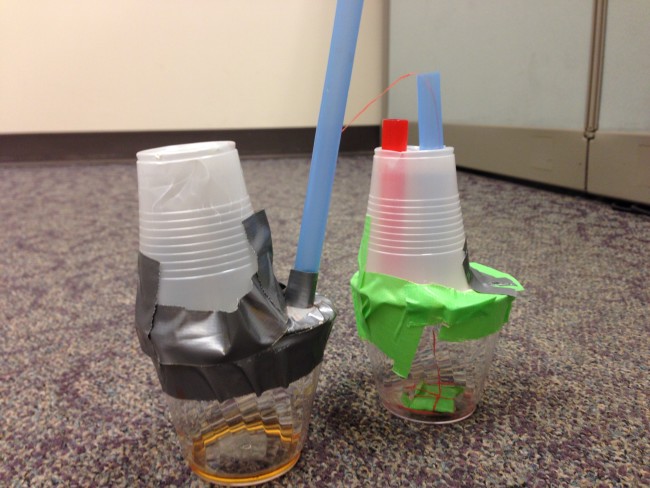
While working with science teachers to integrate the Engineering Design Process (EDP) into their classroom, I noticed a trend: the EDP has more of a presence in chemistry, physics and especially STEM-based earth science classes. Life science teachers — biology or anatomy & physiology — often struggle to locate resources in order to plan lessons or units around the EDP.
As a coach, I hear teachers expressing their fear by saying that it will take up too much time, or they worry that an EDP-based activity may not align with many of their curriculum standards. Understanding that their concerns are valid to them, my role as a coach is to engage in a conversation with those teachers. By talking through the units and the lessons, teachers often discover that the EDP aligns nicely with the curriculum of any science subject.
Since September, I have been working with Enid Duncan, an anatomy & physiology teacher at Panther Creek High School. At first, she wondered if it would just be too difficult and time-consuming for her to integrate the EDP.
The proverbial lightbulb came on as Ms. Duncan was talking about the cardiovascular unit. From that conversation, a plan materialized. The plan was to use the EDP to enhance student understanding of how a heart works. During the lesson planning stage, we discussed not only the EDP, but also the logistics of how to implement the EDP over the course of two or three days.
Putting EDP into Action in the Classroom
The Engineering Design Process is a cyclical model, consisting of the following steps:
- Ask
- Imagine
- Plan
- Create
- Improve
Day 1:
- Ask. Students were tasked with designing a two-chambered heart where “blood” (tap water and red dye) would enter through one vessel in order to fill up a chamber, but when the chamber was inverted (to mimic a heartbeat/contraction of the heart muscle) the “blood” had to flow out of another vessel and not through the one used to get liquid into the chamber.
- Imagine & Plan. Students quickly realized that in order to make this happen, they needed a valve. During the imagine stage and the plan stage, the valve received most of the attention. Ms. Duncan combined these two steps because students discuss, sketch, discuss again, and re-design all in one discussion. The two-step cycle continues until time is called. Students sketch their plan and have until the next day to gather the materials based on the list they created during the planning stage. As examples, students brought in cups, string, ping pong balls, foam, batteries, and straws.
Day 2:
- Create. Students worked in groups of 2-4 to put together their design. This took a majority of the class period. Students created their designs based on their plan. If it failed, they were tasked with going back through the imagine stage and plan stage again, for as long as time allows. At the end of class, the goal was to have a working model.
Day 3:
- Improve. Students presented their design to the class, and in doing so they discussed how their design could be improved. As expected, some students had solid design but maybe the materials didn’t hold up well once wet, and some students simply didn’t have designs that worked, but they knew what needed to be done to make it work because their peers provided them with feedback. During their presentation they had to comment on what they learned, what materials were used, and what their next iteration may look like.
- It is important to note that the presentation was an effective way to get students to describe their design and tie the parts of the model to parts of an actual heart. This truly integrates science content and the engineering design process.
Debriefing with Ms. Duncan
I visited Ms. Duncan’s first period class in order to collect “I notice/ I wonder” data. Based on that data, she and I worked during her planning period to create a more focused student learning question (SLQ) to guide my data collection during the next two class periods.
During third period, I collected student dialogue and tallied if it was “on topic” or “off topic.” Dialogue was considered on topic if students were either referencing the EDP, formally or informally, or if that were talking about the structure or function of the heart.
Ms. Duncan wanted to know what students were saying concerning the heart in order to catch any misconceptions. She wanted to know how well they utilized the EDP so she could improve upon the instructions given for this activity.
Findings
Students referenced the EDP and the anatomy/physiology of the heart a majority of the time. Any off topic conversations were not sustained for large periods of time, and they did not distract from the work.
What was interesting to note is that some groups tended to reference the engineering aspect of the lab, while neglecting to mention the function of the heart, while the opposite was true in other groups. This led Ms. Duncan and I to wonder if this was created by allowing students to pick their own groups, enabling them to select like-minded individuals. We also wondered if this was an issue that she needed to be concerned with changing.
Conclusion
The standards in place around science education, although rich in content, recognize that science is more than content knowledge. Over a century ago, Dewey stated, “the future of our civilization depends upon the widening spread and deepening hold of the scientific habit of mind” (Dewey, 1910. P.126). These “habits of the mind” (Çalik & Coll, 2012; Dewey, 1910) align with science and engineering practices in that they call for those who practice in the field to be purposeful, reflective, and thoughtful. To this end, the EDP can be a valuable tool when learning life science through inquiry, as it promotes critical thinking and focuses on the importance of solving problems.
For more information about integrating the EDP into K-12 classrooms, visit teachengineering.org.
Lindsay Patterson is an instructional coach with NC New Schools.

























